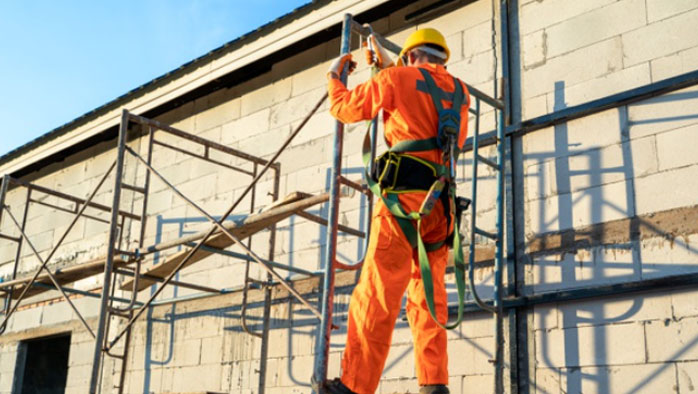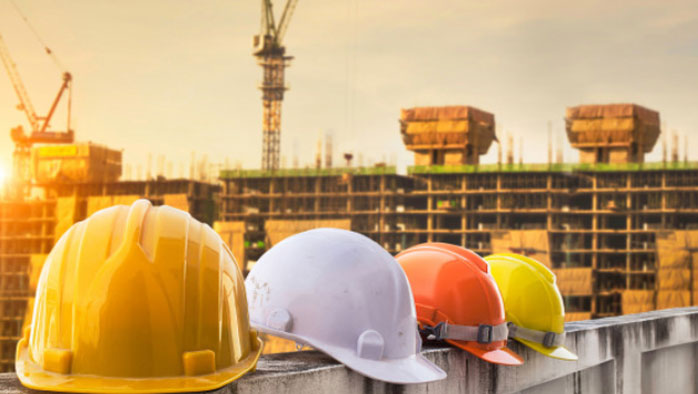
In Saudi Arabia and other Middle East countries construction industries and Scaffolding manufacturers and suppliers follow the OSHA (USA), Saudi Aramco KSA, and Adnoc, Enoc, UAE recommended scaffold safety procedure requirements guidelines. ARABIAN SPAR CO LTD is the most reliable and trusted name in scaffolding companies for manufacturing, storing, supplying, erecting, dismantling, etc. of scaffolding products—like scaffolding pipe, galvanized tubes, Scaffold steel board, scaffold metal deck, etc. and services in the Middle East and other MENA countries. However, this article is based on OSHA scaffold safety guidelines. The scaffold safety procedure requirements are given in detail with more specific information in the OSHA guidebook. But the same safety requirements in this article are briefed
Safety Requirements for Scaffolds

Safety Criteria Requirements for Suspended Scaffolds
- The safety criteria requirements for Suspended Scaffolds are as follows:
- Only those items specifically designed as counterweights must be used.
- Counterweights used for suspended scaffolds must be made of materials that cannot be easily dislocated. Flowable material, such as sand or water, cannot be used.
- Counterweights must be secured by mechanical means to the outrigger beams.
- Vertical lifelines must not be fastened to counterweights.
- The materials like sand, masonry units, or rolls of roofing felt cannot be used for counterweights.
- No. Such materials cannot be used as counterweights.
- Outrigger beams (thrust-outs) must be placed perpendicular to their bearing support.
- Tiebacks for outrigger beams, cornice hooks, roof hooks, roof irons, parapet clamps, or similar devices must be secured to a structurally sound anchorage on the building or structure. Sound anchorages do not include standpipes, vents, other piping systems, or electrical conduit.
- A single tieback must be installed perpendicular to the face of the building or structure. Two tiebacks installed at opposing angles are required when a perpendicular tieback cannot be installed.
- The suspension ropes must be long enough to allow the scaffold to be lowered to the level below without the rope passing through the hoist, or the end of the rope configured to prevent the end from passing through the hoist.
- The scaffolding standard requirement prohibits using repaired wire.
- Drum hoists must contain no less than four wraps of the rope at the lowest point.
- Employers must replace wire rope when the following conditions exist: kinks; six randomly broken wires in one rope lay or three broken wires in one strand in one lay; one-third of the original diameter of the outside wires are lost; heat damage; evidence that the secondary brake has engaged the rope; and any other physical damage that impairs the function and strength of the rope.
- Suspension ropes supporting adjustable suspension scaffolds must be a diameter large enough to provide sufficient surface area for the functioning of brake and hoist mechanisms.
- Suspension ropes must be shielded from heat-producing processes.
- Power-operated hoists used to raise or lower a suspended scaffold must be tested and listed by a qualified testing laboratory.
- The stall load of any scaffold hoist must not exceed three times its rated load.
- The stall load is the load at which the prime-mover (motor or engine) of power-operated hoist stalls or the power to the prime-mover is automatically disconnected.
- Gasoline power-operated hoists or equipment are not permitted.
- Drum hoists must contain no less than four wraps of suspension rope at the lowest point of scaffold travel.
- Gears and brakes must be enclosed.
- An automatic braking and locking device, in addition to the operating brake, must engage when a hoist makes an instantaneous change in momentum or an accelerated overspeed.
- Manually operated hoists used to raise or lower a suspended scaffold must be tested and listed by a qualified testing laboratory.
- These hoists require a positive crank force to descend.
- No materials or devices may be used to increase the working height on a suspension scaffold. This includes ladders, boxes, and barrels.
Welding can be done from suspended scaffolds when

- A grounding conductor is connected from the scaffold to the structure and is at least the size of the welding lead;
- The grounding conductor is not attached in series with the welding process or the workpiece;
- An insulating material covers the suspension wire rope and extends at least four feet (1.2 meters) above the hoist;
- Insulated protective covers cover the hoist;
- The tail line is guided, retained, or both so that it does not become grounded;
- Each suspension rope is attached to an insulated thimble; and
- Each suspension rope and any other independent lines are insulated from grounding.
Safety Requirements for Access to Scaffolds
- Employers must provide access when the scaffold platforms are more than 2 feet (0.6 meters) above or below a point of access.
- Direct access is acceptable when the scaffold is not more than 14 inches (36 centimeters) horizontally and not more than 24 inches (61centimeters) vertically from the other surfaces.
- The scaffolding standard prohibits the use of cross-braces as a means of access.
- Employees erecting and dismantling supported scaffolding must have a safe means of access provided when a competent person has determined the feasibility and analyzed the site conditions.
Some types of access are permitted to scaffolds, such as
- Ladders, such as portable, hook-on, attachable, and stairway,
- Stair towers,
- Ramps and walkways, and
- Integral prefabricated frames
Safety Requirements Prohibit the Use of Some Types of Scaffolds
- Shore and lean-to scaffolds are strictly prohibited.
- Also, employees are prohibited from working on scaffolds covered with snow, ice, or other slippery materials, except to remove these substances.
- The standard requires specific clearance distances between scaffolds and powerlines.
Safety Requirements for Fall Protection from Scaffolds
Fall Protection
- Fall protection includes guardrail systems and personal fall arrest systems. Personal fall arrest systems include harnesses, components of the harness/belt such as Dee-rings, and snap hooks, lifelines, and anchorage points.
- Vertical or horizontal lifelines may be used.
- Lifelines must be independent of support lines and suspension ropes and not attached to the same anchorage point as the support or suspension ropes.
- When working from an aerial lift, attach the fall arrest system to the boom or basket.
Fall Protection Requirements for All Scaffolds
- Employers must provide fall protection for each employee on a scaffold more than 10 feet (3.1 meters) above a lower level.
- A competent person must determine the feasibility and safety of providing fall protection for employees erecting or dismantling supported scaffolds.
The Type of Fall Protection Required for Specific Scaffolds
| Type of Scaffold | Fall Protection Required |
| Aerial lifts | Personal fall arrest system |
| Boatswains’ chair | Personal fall arrest system |
| Catenary scaffold | Personal fall arrest system |
| Crawling board (chicken ladder) | Personal fall arrest system, or a guardrail system, or by a 3/4 inch (1.9 cm) diameter grabline or equivalent handhold securely fastened beside each crawling board |
| Float scaffold | Personal fall arrest system |
| Ladder jack scaffold | Personal fall arrest system |
| Needle beam scaffold | Personal fall arrest system |
| Self-contained scaffold | Both a personal adjustable scaffold arrest system and a guardrail system |
| Single-point and two-point suspension scaffolds | Both a personal fall arrest system and a guardrail system |
| Supported scaffold | Personal fall arrest system or guardrail system |
| All other scaffolds not specified above | Personal fall arrest system or guardrail systems that meet the required criteria |
Safety Requirement of Personal Fall Arrest Systems When Working on Scaffolding and Aerial Lifts

- Personal fall arrest systems can be used on scaffolding when there are no guardrail systems.
- Use fall arrest systems when working from the following types of scaffolding: boatswains’ chair, catenary, float, needle beam, ladder, and pump jack.
- Use fall arrest systems also when working from the boom/basket of an aerial lift.
Safety Requirement for Both Fall Arrest and Guardrail Systems
Each employee on a self-contained adjustable scaffold shall be protected by a guardrail system (with minimum 200-pound top-rail capacity) when the platform is supported by the frame structure, and by both a personal fall arrest system and a guardrail system (with minimum 200-pound top-rail capacity) when the platform is supported by ropes.
Safety Requirement for Falling Object Protection
To protect employees from falling hand tools, debris, and other small objects, install toeboards, screens, guardrail systems, debris nets, catch platforms, canopy structures, or barricades. Also, employees must wear hard hats.
Specific Scaffolds Additional Safety Requirements
The scaffolding standard rule addresses other requirements for specific types of scaffolds such as the mobile, ladder, and pump jack, fabricated frame, and tube and coupler scaffolds.
Scaffold Aerial Lift Safety Requirements
Scaffold Aerial Lifts
Vehicle-mounted aerial devices used to elevate employees, such as extensible boom platforms, aerial lifts, articulating boom platforms, and vertical towers are considered “aerial lifts”.
Specific Safety Requirements for Aerial Lifts
- Only authorized personnel can operate aerial lifts.
- The manufacturer or equivalent must certify any modification.
- The insulated portion must not be altered to reduce its insulating value.
- Lift controls must be tested daily.
- Controls must be marked clearly.
- Brakes must be set and outriggers used.
- Boom and basket load limits must not be exceeded.
- Employees must wear personal fall arrest systems, with the lanyard attached to the boom or basket.
- No devices to raise the employee above the basket floor can be used.
Training Requirements for Scaffolds Safety Procedures

The scaffolding standard requires retraining when
(1) no employee training has taken place for the worksite changes, scaffold changes, or falling object protection changes; or
(2) where the employer believes the employee lacks the necessary skill, understanding, or proficiency to work safely.
Arabian Spar is supported by its qualified and experienced R&D team having the expertise in the application of the advanced technology of construction field used in the USA, European Union, Japan, Australia, etc. for scaffoldings production to ensure the scaffolding standard quality of SGS, JIS, ASTM, BS, and others.
Arabian Spar came into being with an aim and objective to be a professional one-stop engineering scaffolding standard quality products and OSHA (USA) standards, Saudi Aramco Scaffold Safety Handbook (SSH), and the Saudi Aramco Construction Safety Manual (CSM), and Adnoc, Enoc, UAE based scaffolding services supplier for erecting and dismantling of scaffolds temporary platform for construction work in Saudi Arabia, UAE, UK, and other Middle East countries.
Arabian Spar Scaffolding standard quality product materials and scaffolding services which meet OSHA, ARAMCO, Adnoc, Enoc, UAEand SABIC specification, and testing are:
A. Arabian Spar Scaffolding Products
- Pipes & Tubes: HR (Black), Galvanized (Hot-Dip) or Pre-galvanized types Round Tubes, Square Tubes, Rectangular Tubes, ERW pipe…
- Cuplock Systems: Vertical Standard (Open End), Ledger (Horizontal), Intermediate
Transom (Horizontal)
- Ringlock Systems: Ledgers, Braces, Hop Up Bracket, Base Collar…
- Tube And Fittings: Galvanised Iron Scaffolding Tubes, Double Coupler, Swivel Coupler, Putlog Coupler, Grider-Coupler, Board Retaining Clamp, Toe Board Couplers, Sleeve Coupler, Ladder Clamp, Rocking Or Swivel Base Plate, Adjustable U Head Jack, Scaffolding Ladder Beams, Scaffolding Ladders, Heavy Duty Self-Closing Scaffolding Gate, Scaffolding Base Plate, Adjustable Base Jack…
- Scaffolding Steel Boards/Plank: Lvl Wooden Scaffold Board, Steel Boards without
- Hooks, Steel Boards with Hooks…
- Ladder & Lattice Beams: Scaffolding Ladder Beams, Scaffolding Ladders, Lattice Beams…
B. Arabian Spar Scaffolding Services
- Contract Scaffolding Services: Construction and plant maintenance in Oil & Gas and Petrochemical sector
- Hire and Sales: With the i-Hire Inventory Management System and control the movement of the equipment throughout the different branches and client Projects around KSA.
- Scaffolding Design & Inspection: conforming to various standards viz. British, European, and American, Australian, Saudi Aramco, and other the Middle East client/project specifications.
- Manpower/Training Supply:
- Manpower— On short term and long-term basis for their requirements during Turn around, shutdowns, operation, maintenance, construction and contracting etc.
- Training— Basic Awareness, Intermediate, & Advanced Scaffolding Training…
Support Services
- Design – Specialized Access Scaffold.
- Design – Formwork & Falsework
- In House Scaffolding Training
- Health and Safety Training
Moreover, by keeping the safety and security of scaffolds structure and workers, scaffolding customers should not compromise with the kinds and quality of scaffolding products and services used in scaffolding works.
Locations for Arabian Spar Scaffolding Products & Services
For Arabian Spar quality scaffolding products and services based on OSHA, Saudi Aramco, and Adnoc, Enoc, UAE safety standard and rules, clients can contact on the following addresses given below:
1. JUBAIL- KSA (H O)
ARABIAN SPAR CO. LTD
King Abdullah Road, After Flyover, Behind KPS 33
Post Box -1396, Al- Jubail – 31951,
Kingdom of Saudi Arabia
Tel : +966 (13) 3619096, +966 (13) 3627320
Fax: 966 (13) 3618032
Email: info@arabianspar.com
2. RIYADH KSA
ARABIAN SPAR CO. LTD
PO Box 4424, Ring Road, Exit-22,
Faryan Street, Riyadh-14515
Saudi Arabia
Mobile: +966 533762893
Tel: +966 11 2044947
Fax: +966 11 2044947
email: info@arabianspar.com
3. DUBAI – UAE
SPAR TRADING LLC
PO Box 15188,
815 F – Ibn Battuta Gate Offices,
Sheikh Zayed Road, Dubai,
United Arab Emirates
Tel: +971 549 985054
Tel:: +971 455 78125
Email: uae@sparindustries.com
4. FACTORY
SPAR SCAFFOLDING FACTORY
Near Riyadh and Saudi
Fransi Bank Behind KPS 33
Al Jubail KSA
Tel : +966 (0)13-3627320
5. RAK – UAE
SPAR STEEL INDUSTRIES LLC
PO Box 37374, Plot No. P111,
Al Ghail Industrial Park,
Ras Al Khaimah, UAE
Tel: +971 7258 9988
Fax: +971 7228 1737
Email: info@sparsteel.com
Website: www.sparsteel.com
6. UK
SPAR SCAFFOLDING LTD.
Suite No. 2, Frendown, Wooderford Road, London England, E18 2 ED
Tel: +971 7258 9988
